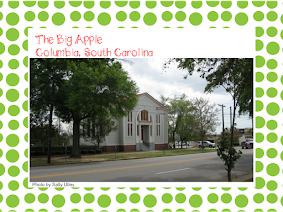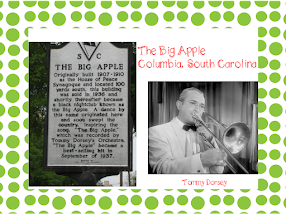What did you think when you read the title of this post? New York City? Of course you did. I thought the same thing when I first learned of this little bit of history. Imagine my surprise to discover that The Big Apple Dance Craze of the 1930's actually began right here in Columbia, South Carolina! As I learned more, I knew that The Big Apple Dance was the perfect "get up and move" activity to insert into my ongoing jazz unit.
What is The Big Apple Dance?
The Big Apple Dance is a group participation circle dance that features a caller who calls out the different dance steps. The caller cues both individual and couple dance steps similar to the Lindy Hop, Shag, Charleston, and other popular dances of the day. At times, when the caller called "shine" followed by one of the dance steps. A solo or couple would move to the center of the circle to dance while the rest dance around them in the circle. It's all about getting people up and moving, and as music educators, we can certainly appreciate the power of music and dance in bringing people together.
So, what's the backstory?
I hope you will take three minutes to watch the above video! Here is a brief outline of the history based on the contents of the video (the historical film footage is totally worth watching!) and other published sources that are linked below.
- The dance began at The Big Apple Dance Club, an African American juke joint in Columbia, SC.
- The excitement around The Big Apple Club was noticed by University of South Carolina students who were allowed to stand in the balcony and watch the dancers. Segregation was still the norm, so the white dancers were not allowed on the dance floor. It is said that they would throw coins down to the dance floor to keep the jukebox going.
- These students spread the dance to Myrtle Beach, SC, and eventually, it made its way to the iconic streets of New York City.
- The Roxy Theatre in NY formed a touring troupe of dancers from Columbia.
- Herbert (Whitey) White, manager of Whitey's Lindy Hoppers saw the Roxy dancers' show.
- Whitey described the dance to Frankie Manning, Whitey's lead dancer, on the phone. Frankie and the Lindy Hoppers were in California filming a movie. Frankie recognized the dance concept as similar to a "ring shout" that he had experienced as a youth in South Carolina. Ring shouts were common among the Gullah people of South Carolina and Georgia.
- This rich blend of cultures and history eventually led to Frankie's choreographed version of The Big Apple, featured in the movie "Keep Punchin'." If you listen to the video below, you can hear Frankie calling out the steps for the dancers.
- As the dance gained popularity, Tommy Dorsey and his band recorded a song called "The Big Apple" in 1937.
.
Frankie Manning's choreographed version is what is commonly taught today. (Many tutorial videos speak of first sequence, second sequence, etc. This refers to the version of the dance in the above video.) However, it's essential to remember that the dance's origins were improvisational, with dancers responding to the caller's cues. The dance was different each time. It is the called version that I use in my classes. Here is a modern example of a called version of the dance.
How I Use The Big Apple in Music Class
I use the following learning sequence:
- Connect with prior learning. I intentionally use this dance lesson with 5th grade students because that is the grade that studies the 1920-30 time period in their social studies class. I ask students to share a few things they remember about the time period, guiding the discussion based on my knowledge of their social studies standards.
- Show the history video & the "Keep Punchin'" video, pausing as needed for discussion.
- Watch some tutorials and practice the steps. As a class, we choose the steps that we can (mostly) perform comfortably.
- Turn on some music, then call out dance steps from the agreed upon list as students perform them. I use a slower tune for our first attempts!
- Try the dance with one of the tunes featured in the videos.
- Allow different students to be the caller.
- Reflect on the dance style, the time period, the music, and any other aspects of the lesson that caught student attention.
Tutorial Videos
As I said above, there are many tutorials demonstrating the Frankie Manning sequences. Most of them teach a sequence of steps instead of individual steps. I was looking for a tutorial that would demonstrate the individual steps and name them. This is harder to find. My favorite tutorial for this is not a great quality video, but each of the steps is done with counts and on-screen labels.
Here is another historical video that calls out some individual steps.
Music for Dancing
Here are a few of the songs for dancing.
.
This video slowed the music down to 80%.
Free Resource
When I teach this lesson, my objectives are to connect with social studies lessons, introduce the history of the dance, and engage with the music of the time period through movement. If we have a little fun along the way, all the better! If you would like to use my lesson slides, which include the links to the above videos, you can find them FREE in my TPT shop by clicking the image link below.
If you are ready to dive deeper into incorporating jazz music into your lessons, check out this post: Unlocking Elementary Skills Through Jazz: Fun & Educational!
I would love to hear about your experiences teaching this fun dance!
Musically yours,
References
http://www.lindycircle.com/history/big_apple/
https://en.wikipedia.org/wiki/Big_Apple_(dance)
https://www.streetswing.com/histmain/z3bigapl.htm
https://www.capetownswing.co.za/2023/05/the-big-apple-a-brief-history-of-a-dance-thats-harder-than-it-looks/
















.png)


0 Comments:
Post a Comment